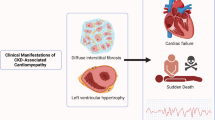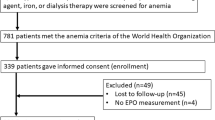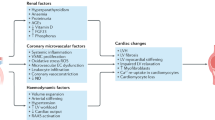Abstract
Congestive heart failure (CHF) and chronic kidney disease (CKD) often progress to end stage even with optimum medical therapy. One factor that is common to both conditions is anemia, which is present in about a third of CHF patients. CHF can cause or worsen both anemia and CKD, and CKD can cause or worsen both anemia and CHF. Thus, a vicious circle exists between these three conditions, with each causing or worsening the other. We have called this condition the cardio–renal–anemia syndrome. Anemia in CHF is associated with increased mortality and hospitalization, reduced cardiac function and evidence of more severe CHF and CKD than in nonanemic patients. Intervention studies in anemic CHF patients have shown that optimum medical treatment of CHF and the correction of the associated anemia with subcutaneous erythropoietin and oral iron or intravenous iron sucrose can improve cardiac function, patients' functional status, renal function and quality of life, and reduce the frequency of hospitalization and the dose of diuretics required.
This is a preview of subscription content, access via your institution
Access options
Subscribe to this journal
Receive 12 print issues and online access
$209.00 per year
only $17.42 per issue
Buy this article
- Purchase on Springer Link
- Instant access to full article PDF
Prices may be subject to local taxes which are calculated during checkout

Similar content being viewed by others
References
Silverberg DS et al. (2003) The effect of correction of anemia in diabetic and non diabetics with severe resistant congestive heart failure and chronic renal failure by subcutanous erythropoietin and intravenous iron: a randomized controlled study. Nephrol Dial Transplant 18: 141–146
Silverberg DS et al. (2003) Erythropoietin should be part of congestive heart failure management. Kidney Int 64 (Suppl 87): S40–S47
Avorn J et al. (2002) Nephrologist care and mortality in patients with chronic renal insufficiency. Arch Intern Med 162: 2002–2006
Perry HM Jr et al. (1995) Early predictors of 15 year end-stage renal disease in hypertensive patients. Hypertension 25: 587–594
Hillege HL et al. (2003). Accelerated decline and prognostic impact of renal function after myocardial infarction and the benefits of ACE inhibition: the CATS randomized trial. Eur J Heart Failure 24: 412–420
Knight EL et al. (1999) Predictors of decreased renal function in patients with heart failure during angiotensin-converting enzyme inhibitor therapy: results from the studies of left ventricular dysfunction (SOLVD). Am Heart J 138: 849–855
Fine LG et al. (2000) Is there a common mechanism for the progression of different types of renal diseases other than proteinuria? Towards the unifying theme of chronic hypoxia. Kidney Int 57 (Suppl 75): S22–S26
Ljungman S et al. (1990) Role of kidney in congestive heart failure. Relationship of cardiac index to kidney function. Drugs 39 (Suppl 4): 10–21
Dries DL et al. (2000) The prognostic implications of renal insufficiency in asymptomatic and symptomatic patients with left ventricular systolic dysfunction. J Am Coll Cardiol 35: 681–689
Zoccali C et al. (2003) Traditional and emerging cardiovascular risk factors in end-stage renal disease. Kidney Int 63 (Suppl 85): S105–S110
Silverberg DS et al. (2000) The use of subcutaneous erythropoietin and intravenous iron for the treatment of the anemia of severe, resistant congestive heart failure improves cardiac and renal function, functional cardiac class, and markedly reduces hospitalizations. J Am Coll Cardiol 35: 1737–1744
National Kidney Foundation (2001) K/DOQI clinical practice guidelines for the treatment of anemia of chronic renal failure. Am J Kidney Dis 30 (Suppl 3): S192–S240
Locatelli F et al. (2004) Revised European best practice guidelines for the management of anemia in patients with chronic renal failure. Nephrol Dial Transplant 19 (Suppl 2): S1–47
Packer M et al. (1999) Consensus recommendations for the management of chronic heart failure. On behalf of the membership of the advisory council to improve outcomes nationwide in heart failure. Am J Cardiol 83: 1A–38A
Hunt SA et al. (2001) ACC/AHA guidelines for the evaluation and management of chronic heart failure: Executive Summary. A report of the American College of Cardiology/American Heart Association Task Force on Practice Guidelines (Committee to Revise the 1995 Guidelines for the Evaluation and Management of Heart Failure). Circulation 104: 2996–2300
Tang WHW et al. (2003) Anemia in ambulatory patients with chronic heart failure: A single-center clinical experience derived from electronic medical records. J Am Coll Cardiol 41 (Suppl A): 1039–1061A
Wexler D et al. (2004) Prevalence of anemia in patients admitted to hospital with a primary diagnosis of congestive heart failure. Int J Cardiol 96: 79–87
Kosiborod M et al. (2003) The prognostic importance of anemia in patients with heart failure. Am J Med 114: 112–119
Tanner H et al. (2002) The prevalence of anemia in chronic heart failure. Int J Cardiol 86: 115–121
Al-Ahmad A et al. (2001) Reduced kidney function and anemia as risk factors for mortality in patients with left ventricular dysfunction. J Am Coll Cardiol 38: 955–962
Cowie MR et al. (1997) The epidemiology of heart failure. Eur Heart J 18: 208–225
Collins AJ (2002) Influence of target hemoglobin in dialysis patients on morbidity and mortality. Kidney Int 61 (Suppl 80): 44–48
Wu WC et al. (2001) Blood transfusion in elderly patients with acute myocardial infarction. N Engl J Med 345: 1230–1236
Langston RD et al. (2003) Renal insufficiency and anemia are independent risk factors for death among patients with acute myocardial infarction. Kidney Int 64: 1398–1405
Reinecke H et al. (2003) Haemoglobin-related mortality in patients undergoing percutaneous coronary interventions. Eur Heart J 24: 2142–2150
McKechnie RS et al. (2004) Prognostic implication of anemia on in-hospital outcomes after percutaneous coronary intervention. Circulation 110: 271–277
Gurm HS et al. (2004) Double jeopardy of renal insufficiency and anemia in patients undergoing percutaneous coronary interventions. Am J Cardiol 94: 30–34
Keane WF et al. (2003) The risk of developing end-stage renal disease in patients with type 2 diabetes and nephropathy: the RENAAL Study. Kidney Int 63: 1499–1550
Levin A (2002) The relationship of hemoglobin level and survival: direct or indirect effects. Nephrol Dial Transplant 17 (Suppl 5): 8–13
Gouva C et al. (2004) Treating anemia early in renal failure slows the decline of renal function: a randomized controlled study. Kidney Int 66: 753–760
Anand IS et al. (1999) Pathogenesis of edema in chronic anemia: studies of body water and sodium, renal function, hemodynamics and plasma hormones. Br Heart J 70: 357–362
Grune T et al. (2000) Oxidative stress in anemia. Clin Nephrol 53 (Suppl 1): S18–22
Hebert PC et al. (2004) Physiologic aspects of anemia. Crit Care Clinics 20: 187–212
Kobayashi H et al. (1989) Circulatory effects of acute normovalemic haemodilution in rats with acute myocardial infarction. Cardiovasc Res 23: 842–851
Tong EM and Nissenson AR (2001) Erythropoietin and anemia. Semin Nephrol 21: 190–203
Iverson PO et al. (2002) Decreased hematopoiesis in bone marrow of mice with congestive heart failure. Am J Physiol Regul Integr Comp Physiol 282: R166–172
Herrera-Garza EH et al. (1999) Tumor necrosis factor alpha. A mediator of disease progression in the failing human heart. Chest 115: 1170–1174
Means RT (1999) Advances in the anemia of chronic disease. Int J Hematol 70: 7–12
Matsouka C et al. (2004) Etiology of anemia in congestive heart failure. Eur J Heart Fail 6 (Suppl): 342A
Schustack A et al. (1985) Intramuscular iron replenishment and replacement combined with testosterone enanthate in maintenance hemodialysis: a follow up of 8 years on 16 patients. Clin Nephrol 23: 303–306
Vaziri ND (2001) Erythropoietin and transferrin metabolism in nephrotic syndrome. Am J Kidney Dis 38: 1–8
Kooistra MP et al. (1998) Iron absorption in erythropoietin-treated haemodialysis patients: effects of iron availability, inflammation and aluminum. Nephrol Dial Transplant 13: 82–88
Silverberg DS et al. (2001) The effect of i.v. iron alone or in combination with low-dose erythropoietin in the rapid correction of anemia of chronic renal failure in the predialysis period. Clin Nephrol 55: 212–219
Androne AS et al. (2003) Hemodilution is common in patients with advanced heart failure. Circulation 107: 226–229
Macdougall IC (1999) The role of ACE inhibitors and angiotensin II receptor blockers in the response to erythropoietin. Nephrol Dial Transplant 14: 1836–1841
Thomas MC et al. (2003) Unrecognized anemia in patients with diabetes. Diabetes Care 26: 1164–1169
Bosman DR et al. (2001) Anemia with erythropoietin deficiency occurs early in diabetic nephropathy. Diabetes Care 24: 495–499
Silverberg DS et al. (2001) The effect of correction of mild anemia in severe resistant heart failure using subcutaneous erythropoietin and intravenous iron: a randomized controlled study. J Am Coll Cardiol 37: 1775–1780
Mancini DM et al. (2003) Effect of erythropoietin on exercise capacity in patients with moderate to severe chronic heart failure. Circulation 107: 294–299
Novak B et al. (2003) Anemia management in an outpatient heart failure center [abstract 386]. J Card Fail 9 (Suppl 1)
Besarab A et al. (1998) The effects of normal as compared with low hematocrit values in patients with cardiac disease who are receiving hemodialysis and Epoetin. N Engl J Med 339: 584–590
Lim CS et al. (2004) Iron and oxidative stress in renal insufficiency. Am J Nephrol 17: 569–575
Martirosyan HA et al. (2004) Differential management of cardiovascular disease in ESRD by nephrologists and cardiologists. Am J Kidney Dis 44: 309–321
Calvillo L et al. (2003) Recombinant human erythropoietin protects the myocardium from ischemia-perfusion injury and promotes beneficial remodeling. Proc Natl Acad Sci 100: 4802–4806
Ehrenreich H et al. (2002) Erythropoietin therapy for acute stroke is both safe and beneficial. Mol Med 8: 495–505
Author information
Authors and Affiliations
Corresponding author
Ethics declarations
Competing interests
The authors declare no competing financial interests.
Rights and permissions
About this article
Cite this article
Iaina, A., Silverberg, D. & Wexler, D. Therapy Insight: congestive heart failure, chronic kidney disease and anemia, the cardio–renal–anemia syndrome. Nat Rev Cardiol 2, 95–100 (2005). https://doi.org/10.1038/ncpcardio0094
Received:
Accepted:
Issue Date:
DOI: https://doi.org/10.1038/ncpcardio0094
This article is cited by
-
Does posttransplant anemia at 6 months affect long-term outcome of live-donor kidney transplantation? A single-center experience
Clinical and Experimental Nephrology (2009)
-
Traditional and emerging cardiovascular and renal risk factors: An epidemiologic perspective
Kidney International (2006)



